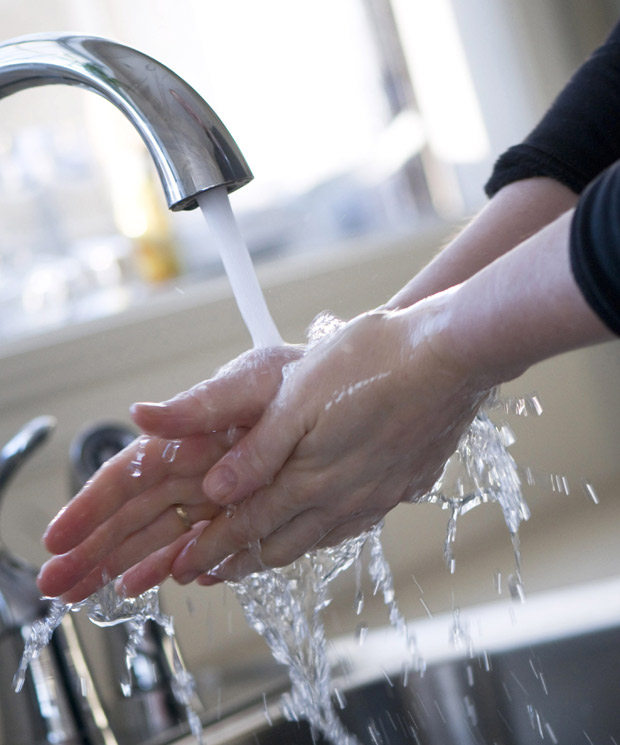Canadians aren’t as careful with personal hygiene compared to fellow nations, according to a new global study on cleanliness and influenza that reveals that only 54 per cent of the country washes their hands at least five times a day.

When it comes to personal hygiene, Canadians ranked fourth behind Brazil, Germany and France after polling 12 countries and 12,000 people in the Global Hygiene Council‘s latest study, the first detailed analysis on country cleanliness, released Wednesday. Results showed that Canada fared better in household hygiene, placing second behind the United Kingdom and Australia.
Still, the findings showed that Canada, along with other nations, has some ways to go before achieving cleanliness levels that would offer sound protection against spreading influenza as the flu season approaches, council chairman and professor Dr. John Oxford said.
“(Canada) is not the best. I thought it would be. In the past couple of years when we arrived in Canada, your hygiene knowledge and application has always been ace because of the SARS outbreak that carried you along,” Oxford said. “And now, for the first time, I think we’ve detected a kind of dip and you’ve slipped a little bit.”
The council is a group of the world’s top experts in hygiene and hygiene-related fields, including microbiology, virology and infectious disease.
In 2003, Ontario was hit with a SARS outbreak while 2008 was marred by a deadly bout of H1N1 across the country.
By 2005, Oxford said experts swabbed Canadian households across the country to collect samples of bacteria that formed in the home.
“It was a monitor, a litmus test of hygiene and you came out very well compared to other countries. Either at the top or near the top,” he said.
“Now you’re not among the worst but you’re not in the top three. But none of you are anywhere near what we’d like to see,” he said.
Researchers selected “very diversified” countries and had 1,000 people that represented different demographic groups in each nation to answer a lengthy questionnaire that was mined for data.
The countries that scored higher than Canada were only slightly ahead, Oxford noted, while on the other end of the spectrum, countries that fared worse had only 30 per cent of people washing their hands five times a day.
Canadian women are two times more likely than men to wash their hands regularly while those with good manners were more likely to have better hygiene, the study reported.
Hand-washing is a strong indication of personal hygiene, Oxford said. At least 90 per cent of the population should be washing their hands half a dozen times a day because hygiene is the first layer of defence against influenza, followed by vaccination and antibiotics.
Dr. Don Low, chief microbiologist at Toronto’s Mount Sinai Hospital, said that Canada’s average seasonal flu vaccination rate is between 35 and 40 per cent. The medical community’s goal is to increase intake up to at least 75 per cent of the population to help stall transmission.
“It’s always a challenge every year as we come into the flu season. People become a bit fatigued with the message and we saw that the year after H1N1, where there was less of a regular uptake of the vaccine,” he said.
He said that last year was one of the worst influenza seasons the country has had in years because lots of people weren’t vaccinated and Canadians, potentially, weren’t as careful with hand-washing and coughing into tissues or into their sleeve to lessen the odds of infecting others and contaminating surfaces.
There are three types of influenza – influenza B, which is more mild and typically results in illnesses in children, and influenza A, which has two strains that could both lead to pandemics.
They include H1N1, which struck in 2008-09, and H3N2, which hit the country last year and resulted in hospitalizations and even fatalities across the country.
Seasonal influenza usually appears on the West Coast first before finding its way across the country, Low said. It peaks around January or February.
So far, one case of H3N2 was reported, but it’s too early to determine what kind of influenza the country could be dealing with later this year.
“Whether or not (that case) is a harbinger of things to come, we don’t know. Right now, it’s anybody’s guess what we’re going to see,” he said.
“We have to continue to be reminded that influenza isn’t associated with just your health. You can be a vehicle of transmission to others.”
Personal hygiene rankings
1 – Brazil
2 – Germany
3 – France
4 – Canada and Middle East
5 – U.K.
6 – Australia and U.S.A.
7 – South Africa and Malaysia
8 – India
9 – China
Household hygiene rankings
1 – U.K. and Australia
2 – Canada
3 – U.S.A.
4 – India
5 – France, Germany and South Africa
6 – Brazil
7 – China, Malaysia and Middle East



Comments